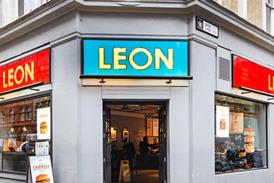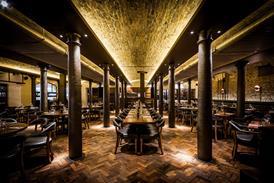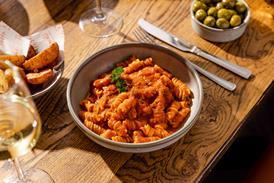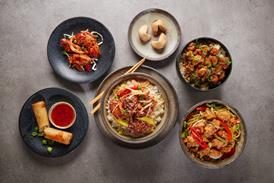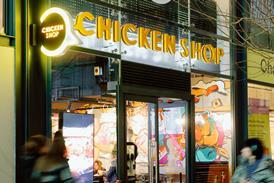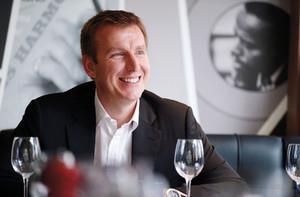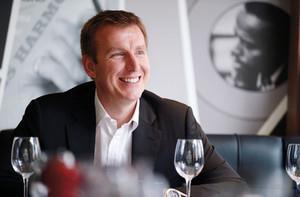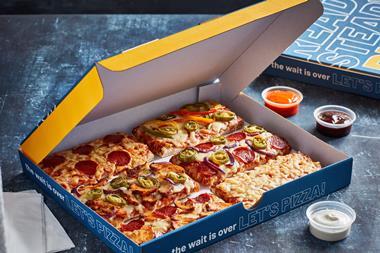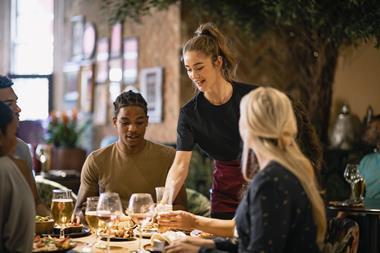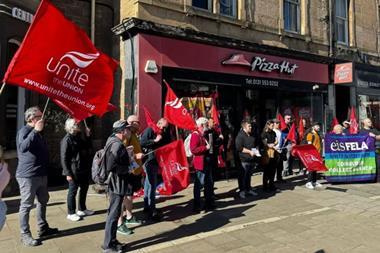The season of changes at the top of the UK’s leading restaurant brands continued earlier this week with the abrupt departure of Richard Hodgson as chief executive of PizzaExpress. Mark Wingett examines his time at the helm of the UK’s largest casual dining brand and why the company’s future growth is increasingly dependent on its expansion plans in the Far East.
“We were having fun at PizzaExpress up to 120 restaurants,” proclaimed David Page, the chain’s former chief executive and co-founder of rival business Franco Manca recently. “Up to 240 it got a bit less exciting and over 240 it got really quite boring.” I doubt Richard Hodgson, who stepped down as chief executive of the brand, which now operates c600 sites, including c440 in the UK, would describe his four years in the PizzaExpress hot seat in the same manner. Challenging yes, boring no.
Within a year of him taking the role, after a highly-regarded career across the food industry sector including senior roles at leading supermarket groups Morrisons and Waitrose, Hodgson was leading the c£900m sale of the business to Hony Capital – at the time it was the largest transaction in the European restaurant sector in the past five years.
Hony, which managed a fund totalling c£4.1bn, is believed to have held off competition from Fosun, the Chinese conglomerate; Citic Capital Partners, another major Beijing-based fund; and American buyout group TPG, to secure the then c500-strong business from Gondola Group. Then Gondola chairman Harvey Smyth said at the time that the company had received “considerable interest” in the business during the sale process. The deal valued PizzaExpress at a multiple of around 10 times. Heady times indeed.
John Zhao, chief executive of Hony, said: “With PizzaExpress, we have the opportunity to leverage our local expertise to accelerate its growth in the Chinese market, as well as to continue to drive its business forward in the UK.”
Fast forward to March 2015, and the company was reporting like-for-like sales that were ahead 6.8% in the 28 weeks to 11 January of that year. It had “positive trading momentum in all areas of the business” as it entered its 50th year as a business. For the full-year to June 2015, UK like-for-like sales were up 5.6%, with turnover rising 9.5% to £427.7m, while EBITDA broke the £100m barrier - up 12.9% to £100.2m.
During 2015, it also bought back its operations in China and Hong Kong; began a delivery trial across two of its London-based sites; developed its own delivery model in Delivered; and launched the trial of new chicken-led concept Reys. There was also talk of introducing new concepts from overseas into the UK market and exploring further growth brands.
By March 2016, the group’s trading momentum was showing signs of faltering, as the UK’s largest casual-dining brand, began to feel the impact of a changing trading environment. Like-for-like sales were up, but by just 0.5% across its UK and Ireland stores for the 28 weeks to 10 January. Turnover during the period grew by 15.9% to £267.2m with EBITDA 3% ahead of last year at £56.4m. By this point the company had completed the acquisition of London-based upscale pizza delivery chain, Firezza and was on the verge of cancelling its plans for Delivered and beginning a national tie-in with Deliveroo across c250 of its restaurants.
No stone was being left unturned by Hodgson to aid the group’s evolution and growth in the UK, but with the trading backdrop becoming increasingly challenging, he was quick to make sure the business “cut its cloth accordingly”. By the middle of 2016, the company had restructured its operations team, taking out the divisional director level and replacing it with five regional operational directors. It also made a number of head office changes.
Hodgson told MCA at the time: “Structures have to be fluid and you have to keep changing them. We have to evolve. I look around my top team and it is better than the team I inherited when I arrived. We have taken the opportunity as people move on to strengthen the team, and that’s how it should be. We’ve had to look at our central costs as our top line hasn’t been growing in proportion.”
Over the course of the year, the company also re-launched its PizzaExpress retail range; entered a new partnership with O2, allowing O2 Priority customers to enjoy a meal at PizzaExpress for just £5 every week; and made further good progress on its strategy for the home-delivery market, beginning the aforementioned link up with Deliveroo and beginning the expansion of Firezza.
However, the new initiative and cloth cutting were not enough at that stage to put a brake on the decline in like-for-like sales, which declined 1.3% in the year to 26 June, which the company said, with some justification, represented a broader slowdown in the casual dining market.
The hope that Reys would become a new growth brand for the business, was extinguished earlier this year, when the sole site under the trial concept in Cambridge was closed and sold to Honest Burgers. But the business continue to ramp up its delivery credentials, commencing a link up in London with Just Eat and further expanding and evolving the Firezza format, leading to the launch of that brand’s first standalone dine-in site in Soho’s Dean Street in April. During the period it also opened its 100th international restaurant located in China, in Guanghzou’s International Grand City Mall.
At the start of last month, the company reported a 0.9% decline in like-for-like sales across its UK and Ireland estate for the 52 weeks ended 1 January 2017 amid a ”softening casual-dining market”.
The group said that it had made a solid start to this year, with like-for-like sales back into growth in UK and Ireland during the first quarter. However, it said the market remained challenging and that actions were “in place to help mitigate UK sector-wide cost pressures”.
Twelve days later, a further part of the brand’s expansion plans was announced, with the signing of its first UK franchise deal, which will see it make its roadside debut with Welcome Break later this year on the M40 near Oxford.
Two weeks later, and the news of Hodgson’s resignation for “personal reasons” was announced. As with David Campbell’s recent abrupt departure from Wagamama, here was a chief executive who was being wished all the best of luck and thanked for his efforts, but yet the absence of Hodgson’s own words in said official release was glaring. He had the task of keeping a 50-year-old restaurant business, with c450 sites in the UK, not only relevant but also moving forward, as you can see from the list of initiatives above he wasn’t found wanting in exploring every avenue to ensure that could happen.
Some have worked better than others, while the jury is still out on a few more. The trials of both Reys and the group’s own standalone delivery model, Delivered, stand out as noticeable missteps, but at least the company was trying to innovate. The thinking behind the development of Delivered, always seemed confusing. Launched through a single site in Exeter, the group was already in talks on Firezza and was at the same trialling its link up with Deliveroo, quickly switching to the two latter and closing the former. It will interesting to see how the c£5.8m acquisition of the then 17-strong Firezza business plays out, especially the dine-in format recently launched in Soho. Does it provide a new growth route or muddy the water for the core brand?
Talk before and at the start of Hony’s involvement in PizzaExpress had been about the further 200 locations the group believes it can open in the UK. It opened 16 new sites in the UK & Ireland in its last financial year, but this has dropped from the 20 a year it was previously launching. In a wider context, it is hard to see many more casual dining brands reaching the level of sites PizzaExpress currently has. Nando’s should do, but that has more to do with its fast-casual-style leanings, while Loungers’ Lounge concept may get there, helped by straddling both the pub and restaurant sectors in the minds of the consumer.
It is something Hodgson was aware of last year. “It is a challenging time, especially for a long-established brand like ours with 450 sites in the UK, some of which are not in the right locations, some of which are now having to compete, in some places, with eight new entrants in that catchment. It makes it really difficult to be able drive like-for-like growth in sites like that,” he told me last July. “On the flip side, and one of the reasons people were keen to buy us three years ago, is that we have a very small tail, there are only a couple of restaurants that lose money. The last time we looked, it was seven, of which four lose less than £10,000 a year. Even sites that were less profitable than they were are still very profitable because of the business model. They only become unprofitable if they come up against the perfect storm; the rents go up and the competition turns up in force – that has happened in certain locations. My property director comes to me every week with a list of what sites our competitors are selling and we look at them all and think should we be more active in disposing of sites? But then why would you dispose of a profitable site?”
At the same time as exploring all angles to drive the UK forward and over the last 12 months, return it to growth. Hodgson was tidying up its international business, buying back key franchise operations, and putting in place the groundwork that will enable it to reach its target of operating 250 restaurants in China by 2020. It currently operates 34 sites in mainland China. Whilst the group’s performance in the UK has fluctuated, its international performance has continued to move forward. In the 79 weeks to 1 January 2017, the group’s c120-strong international business generated turnover of £97.2m, with its operation in China accounting for £80.7m of that figure. In the latest accounts the company said its international division was showing “strong growth across all territories”.
The challenge to continue the improvement here and build on the momentum overseas now falls to new chief executive Jinlong Wang, who until earlier this week was the company’s chairman and interim chief executive of its business in China. An unknown quantity here, the former legal counsel to Starbucks founder Howard Schultz, led the team that launched the coffee-chain brand in China and oversaw the rollout of 2,500 sites there, creating “a new coffee culture” in the traditionally tea-drinking country in the process.
Speaking about his appointment last July, Hodgson said: “Jinlong has an amazing track record. He is helping me with our plans and expansion there. We currently have 24 sites in China and 15 in Hong Kong. We plan to open 250 restaurants by 2020 in mainland China and I am confident we will do that. We opened a site in Hong Kong two months ago and it is 40% ahead of expectations. We recently opened a site in Guangzhou that is taking £30,000 a week.”
Following Hodgson’s departure, Wang said: “The UK remains central to our strategy, and continued success and investment there is the foundation for developing the brand internationally. I am greatly looking forward to the future as we embark on what is a truly ambitious programme for global expansion.” How central the UK will be to the next stage of the brand’s growth will be the interesting part and not just because of Wang’s background, but the potential the company’s obviously believes exists in the Far East. Although the fact that for now Wang will be based in London, should assuage some fears that the UK business will become a secondary priority.
In an interview with the South China Morning Post at the end of last year, Wang vowed to target the premium end of the casual dining market where Western dining among Chinese Millennials has become prevalent, with an ongoing nationwide branding revamp and the launch of a fast-casual brand. The company recently completed that revamp, converting PizzaExpress back to the PizzaMarzano name. Whilst some analysts in the country have voiced concerns about the possibility of success for Western pizza brands in China, Wang believes PizzaExpress’ premium credentials will win out. The group is also set to invest significant funds in introducing mobile ordering across its estate in China. As Wang said in the same interview in regards to the brand’s plans in the country “money is not an issue”.
Closer to home, it will be interesting to see if he will look to tackle the group’s long-term reliance on discounting, an issue that was believed to have vexed former chief executive Steve Easterbrook. He will also have to contend with the issue of whether the company will become over-reliant on its growing delivery business – a concern believed to be shared at Wagamama and Byron. Indeed, the group said that its like-for-like growth improved significantly during the second half of 2016 as the partnership with Deliveroo began to deliver additional sales growth.
Hodgson always bridled at the suggestion that the group’s drop in performance was due in some measure to the rise of “better pizza” concepts such as Franco Manca and Pizza Pilgrims. He told me last year: “I sometimes take offence when people say ‘are you worried about the better pizza players?’, I’m like ‘hang on a minute, no one sells better pizza than we do’. Franco Manca pizzas or Pizza Pilgrims pizza are not a patch on our pizzas in our opinion. There isn’t just the threat of the better pizza players there is the threat of more pizza players and more players full stop. We compete with everyone.” And while the two businesses mentioned may have impacted the group’s performance in some way in London and part of the south east, there are huge swathes of the country where PizzaExpress does not compete with them. I would suggest it is the improvement in the pizza offers across a number of pub operations or the growth of pub company-backed operations, such as The Stable, which has applied more widespread pressure on the brand.
Wang will also be faced with dealing with the wider issue of the UK’s premium and mid-market casual-dining sector coming under increasing pressure. Jamie’s Italian has already closed six under-performing sites and the recent sparse update from Carluccio’s, which barely mentioned current trading performance, threw up more questions than answers.
If money is not an issue for Hony in terms of expansion in China, then it may also come into play with regards to exploring bolt-on opportunities here. I understand that the company was the last suitor standing in the process to acquire Jamie’s Italian, before the business was taken off the market. Speaking to me back in October 2015, Hodgson said: “We have 453 restaurants here in the UK & Ireland and eventually we will run out of space for our restaurants as we know them. So we will look at other cuisines, we will look at other types of proposition. We are not arrogant enough to think that everything we look at will be a success and I am sure we will make many mistakes before we get things right. We have got the business model, investment and restaurants expertise to look at other opportunities. There are lots of assets available both here and internationally. We cast our eye over everything, as I am sure most of our competitors do. What we have at PizzaExpress is a fantastic model where you could acquire, build or bolt-on new businesses, then a bit like Gondola did with Byron, sell it on. We are constantly looking.” You would expect the company to continue with that strategy.
There is a sense that for all the initiatives and changes Hodgson put in place, the pressure from Hony to deliver quicker on its investment remained high. However, having begun to see an upturn in performance you would have thought that might have eased. The current trading climate isn’t going to get any easier soon and Hodgson has arguably done well to keep the business from regressing further/back in growth.
My sense is that the goal posts on what was an acceptable level of performance from the business, especially in the UK, may have been moved once or twice too often for Hodgson’s liking, leading to the abrupt departure. He has already intimated that he will now look at making a return to the grocery sector, suggesting he was slightly stung by his experience at PizzaExpress. But you would like to think that in a market where experienced chief executives are at a premium, he could at some stage make a return to this sector, as you sense he would be a good fit, possibly for a brand that has more headroom for growth domestically.
A lot in the short-term for PizzaExpress in the UK will rest on the shoulders of the management team Hodgson leaves behind – especially chief financial officer Andy Pellington and chief operating officer Zoe Bowley – as Wang finds his feet in his new role. Looking at the current makeup of the group’s board, which includes Wang, Pellington and five further Hony representatives, it begs the questions whether the company should look to bring in a further executive with UK restaurant sector experience.
During his time as chairman, Wang will have seen the challenges and opportunities facing a business that operates in 14 territories, employing more than 14,000 team members, serving guests in 600 restaurants and generating in excess of £500m in revenue.
He will also be aware that the ongoing uncertainty, economic challenges and competition from both established and new concepts, means the reality the company is facing is challenging because there are few immediate solutions or quick fixes – as Hodgson would have pointed out.
He will need to build on all the heritage, loyalty and respect the brand has built up over the last 52 years. I doubt he will find the task ahead boring.


